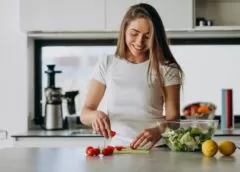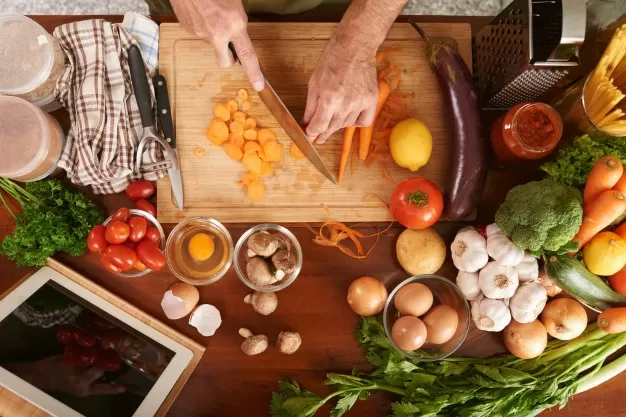Every cook loves to learn new things about cooking. The same can be said about novice cooks. Cooking can be a chore sometimes, but more often, it can just be an enjoyable experience that culminates in a delicious meal. This article can add to your knowledge and joy of cooking.
An excellent area is the best place for you to keep your spices for maximum freshness and taste. If they are exposed to light, heat, or humidity, they will lose much flavor. Generally, ground spices and herbs keep most of their flavor for a year. Whole spices keep their robust flavors for up to five years. When spices are stored accurately, they will stay fresh for much longer.
While most seasonings are added during the cooking process, certain spices are considered good after cooking options. These spices are garlic powder, black pepper, cayenne pepper, and salt. Set these on the table, and let your guests decide on their personal preference to add a little kick to their plate.
Leftover vegetable pieces shouldn’t go to waste. Broccoli tops, carrot pieces, and onion peelings can be added to your vegetable, beef, or chicken stock to fill it with extra flavor. Don’t forget to add the stock to your favorite meals to enhance their flavor and appear as a great cook in front of your friends and family.
Add salt and horseradish to your foods if you want to instill more flavor, and add spice to each of your meals during the day. These ingredients are found everywhere and are very inexpensive, allowing you to maximize your taste level with very minimal expenses. You can improve the flavor of many foods with these ingredients.
Use a collapsible steamer basket to make the best-steamed vegetables. These devices are available widely and cheaply. They can slip into almost any pot you already have and can be used for almost any vegetable you would like to enjoy. Be sure to watch your cook time to avoid getting mushy vegetables.
If you choose the wooden versions of cooking skewers, it is good to immerse them in water and leave them there for about half an hour before using them. That way, you won’t be able to burn them as quickly. Also, use two skewers through your food to help secure it, so it doesn’t end up on the ground.
First, cover the raw seeds in melted butter, olive, or vegetable oil when cooking pumpkin seeds. Then spread them evenly across a cookie sheet and sprinkle them with your favorite seasonings. Bake the seeds at 300 degrees Fahrenheit for about forty-five minutes or until golden brown.
When cooking with a sauté pan, turn its handle in the opposite direction. Keeping the handle facing you increases the chance of bumping into and spilling your food. This is also a safety concern because you can burn yourself if the pan tips or falls over.
All cooks must organize their cooking supplies. If your supplies aren’t organized, you’ll be spending much time trying to remember where everything is. Put all the things that are the same in one place. To be more specific, put peanut butter and jelly on the same shelf since they both serve the same purpose.
Here is a cooking tip that will make your life easier on nights and weekends. When cooking, save any sauces leftover from cooking by pouring them into ice cube trays. When you need to use the sauce cubes, pop them out of the tray and reheat them in a saucepan for a quick sauce without all of the cooking time.
Don’t spend too much time buying books and searching the Internet for exotic fare worldwide, and forget the recipes that your family has served for years. Often the most basic recipes are the most cherished ones. Make sure you write those recipes down. No matter how simple they are, there may be a day when a family member wants them.
Store your spices and herbs in a relaxed and dark area, and keep them away from the stove. Doing this ensures your spices are always rich with flavor every time you reach for them. Heat, humidity, and light will cause your herbs to lose their flavor much faster.
Cutting onions does not have to be a crying matter. The keys to success with onions are easy to follow and minimize tears. Chill the onions first before cutting, use your sharpest knife for cutting and turn exposed cuts down on your board. As you cut, be efficient, quick, and constantly turn the most extensive exposed cuts down against the board. Running your vent hood will help circulate air as you cut as well.
Keep a pack of unflavored, unwaxed dental floss in your kitchen. Dental floss is typically much more effective than using even the sharpest kitchen knife because of its small width if you need to make clean, precise cuts. Pass the piece of dental floss through the item you are cutting for a nice, clean slice.
Make red beans, sausage, and rice the easy way. Brown your sausage in a skillet. Add a can of red beans, liquid included, and then add enough instant rice to soak up the juices. Once the sausage is fully cooked, turn off the heat and let the mixture simmer. It is a filling, low-cost meal that you can prepare in minutes.
To remove the peel from a clove of garlic quickly and easily, carefully smack the heel of your hand on the side of a wide knife blade (laid flat over the clove) to crush the garlic a bit, allowing the skin to slip right off. As a bonus, the flattened clove will be easier to mince before adding it to your dish.
As stated at the beginning of the article, cooking is a joy whether you are experienced or just beginning. A good cook is always learning new things and experimenting. By reading this article and adding to your repertoire of cooking skills, you also add to your enjoyment of a meal that is well done.



